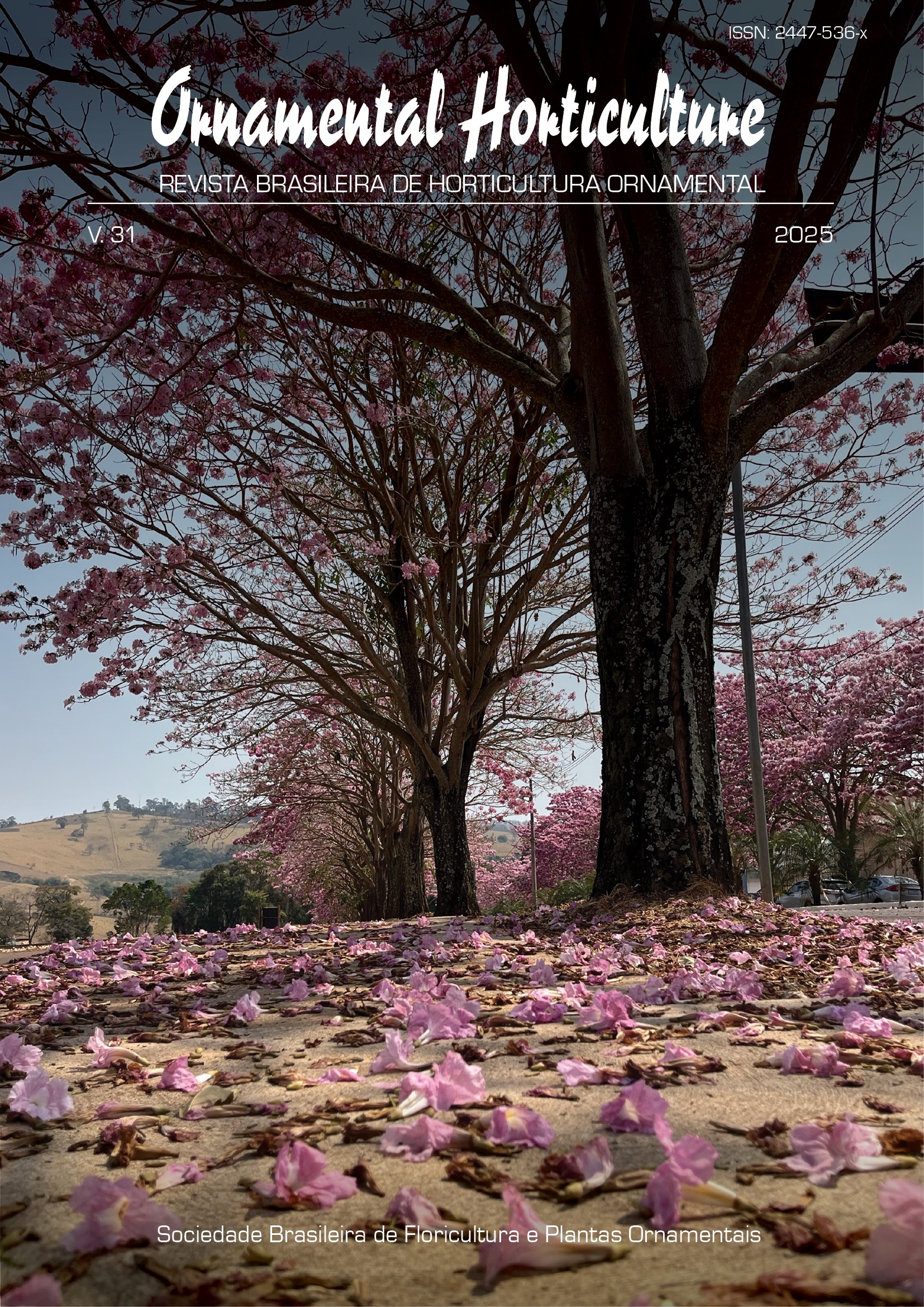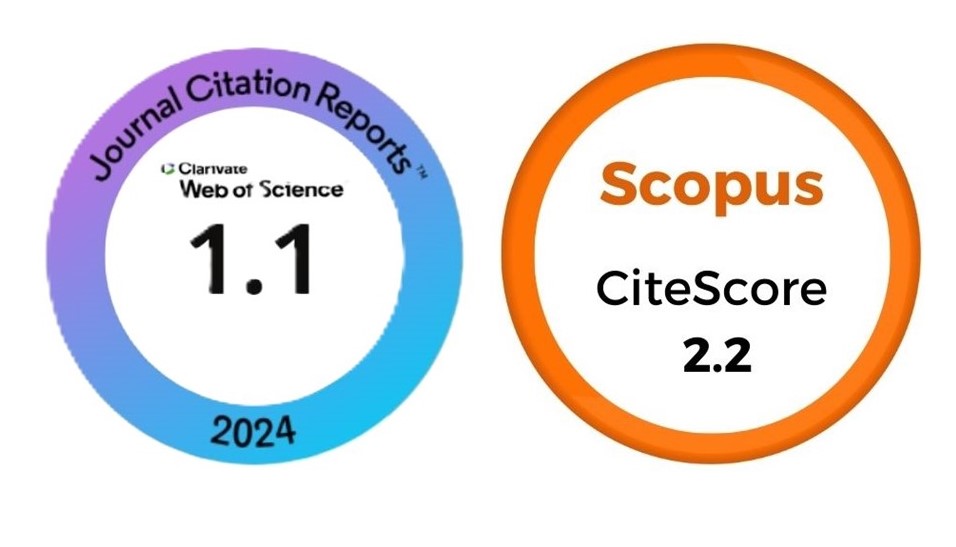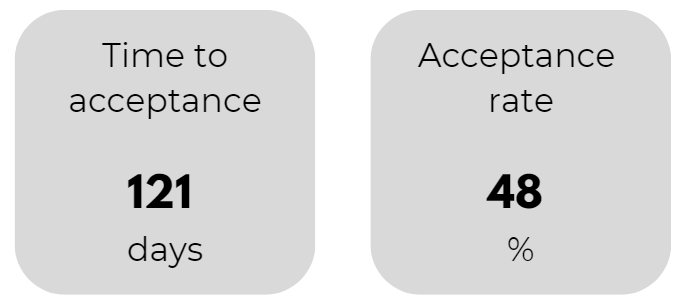UV-C light irradiation effects on two rose cultivars infected with Botrytis cinerea
DOI:
https://doi.org/10.1590/2447-536X.v31.e252761Keywords:
epidermis, gray mold, polar Star, postharvestAbstract
Gray mold (Botrytis cinerea Pers.: Fr) is one of the most important diseases that cause great economic losses in cut roses. Chemical fungicides are widely used for disease management. However, these products have a large accumulation of residues and select strains resistant to pathogens and pesticides. In this context, the irradiation of plants with UV-C light (254 nm) is an effective treatment for the control of several phytopathogens. In this study, the in vitro effect of three doses of UV-C light (1.0, 1.5, and 2.0 kJ m-2) on conidia germination and B. cinerea mycelial growth was evaluated. In addition, in vivo trials were carried out on two white rose cultivars “Polar Star” and “Proud”. For this, the stems of the roses were irradiated with UV-C light before inoculation of B. cinerea or inoculated directly with irradiated conidia. The in vitro experiments showed inhibition of more than 90% of conidia germination and the total inhibition mycelial growth, at any of the doses evaluated. In addition, infection of rosebuds was significantly reduced or avoided when they were inoculated with irradiated conidia. When roses were irradiated with the same doses and inoculated with viable conidia, symptoms appeared more quickly and differences between varieties were more evident. The histological analysis of the rose petals showed that the petals of the roses cv. Proud had thicker abaxial and adaxial epidermis, with numerous elongated cone-shaped papillae, which may confer greater tolerance to Botrytis infections.
Downloads
References
ABBEY, J.A.; PERCIVAL, D.; ABBEY, L.; ASIEDU, S. K.; PRITHIVIRAJ, B.; SCHILDER, A. Biofungicides as alternative to synthetic fungicide control of grey mould (Botrytis cinerea) – prospects and challenges, Biocontrol Science and Technology, v.29, n.3, p.207-228, 2019. https://doi.org/10.1080/09583157.2018.1548574
BARNETT, H. L.; HUNTER, B. B. Illustrated genera of imperfect fungi. Minesota, USA: American Phytopathological Society, 1998. 218 p.
BAUTISTA-SILVA, J.P.; BARBOSA-BARBOSA, H.J.; URIBE-VÉLEZ, D. Formulation prototype based on Rhodotorula mucilaginosa for the control of Botrytis cinerea in roses. Revista Colombiana de Biotecnología, v.18, n.2, p.13-23, 2016. https://doi.org/10.15446/rev.colomb.biote.v18n2.55826
BERGOUGNOUX, V.; CAISSARD, J.C.; JULLIEN, F.; MAGNARD, J.L.; SCALLIET, G.; COCK, J.M.; BAUDINO, S. Both the adaxial and abaxial epidermal layers of the rose petal emit volatile scent compounds. Planta, v.226, n.4, p.853-866, 2007. https://doi.org/10.1007/s00425-007-0531-1
BIKA, R.; BAYSAL-GUREL, F.; JENNINGS, C. Botrytis cinerea management in ornamental production: a continuous battle. Canadian Journal of Plant Pathology, v.43, n.3, p.345-365, 2021. https://doi.org/1 0.1080/07060661.2020.1807409
BYEONG-MING, S.; GUN-HEE, L.; HEE-JEONG, H.; JU.HEE, Y.; EUN-GYEONG, L.; HYUNJI, G.; HA-KYEONG, P.; KYUNGA, R.; JINWOO, K.; SANG-MIN, K.; DONGSEOB, T. Ultraviolet-C light at 222 nm has a high disinfecting spectrum in environments contaminated by infectious pathogens, including SARS-CoV-2. PLoS One, v.18, n11, e0294427, 2023. https://doi.org/10.1371/journal.pone.0294427
CARISSE, O.; VAN DER HEYDEN, H. Relationship of airborne Botrytis cinerea conidium concentration to tomato flower and stem infections. Plant Disease, v.99, n.1, p.137-142, 2015. https://doi.org/10.1094/PDIS-05-14-0490-RE
CHEUNG, N.; TIAN, L.; LIU, X.; LI, X. The destructive fungal pathogen Botrytis cinerea—Insights from genes studied with mutant analysis. Pathogens, v.9, n.11, p.923, 2020. https://doi.org/10.3390/pathogens9110923
CUN, SL; ZHANG, C.; CHEN, J.; QUIAN, L.; SUNA, H.; SONG, B. Effects of UV-B radiation on pollen germination and tube growth: A global meta-analysis. Science of the Total Environment, v.915, 170097, 2024. https://doi.org/10.1016/j.scitotenv.2024.170097
DARRAS, A.I.; DEMOPOULOS, V.; TINIAKOU, C. UV-C irradiation induces defense responses and improves vase-life of cut gerbera flowers. Postharvest Biology and Technology, v.64, n.1, p.168–174, 2012. https://doi.org/10.1016/j.postharvbio.2011.07.008
ELAD, Y.; PERTOT, I.; PRADO, A.M.C.; STEWART, A. Plant Hosts of Botrytis spp. In: FILLINGER, S.; ELAD, Y. (eds) Botrytis–the fungus, the pathogen and its management in agricultural systems. New York: Springer International Publishing, 2016. p.413-486.
FERNÁNDEZ-ORTUÑO, D.; PÉREZ-GARCÍA, A.; CHAMORRO, M.; DE LA PEÑA, E.; DE VICENTE, A.; TORÉS, J. A. Resistance to the SDHI fungicides boscalid, fluopyram, fluxapyroxad, and penthiopyrad in Botrytis cinerea from commercial strawberry fields in Spain. Plant Disease, v.101, n.7, p.1306-1313, 2017. https://doi.org/10.1094/PDIS-01-17-0067-RE
DEWEY, F.M.; GRANT-DOWNTON, R. Botrytis-Biology, Detection and Quantification. p.17-34. In: Botrytis – the Fungus, the Pathogen and its Management in Agricultural Systems. Fillinger, S., Elad, Y. (eds). 2016. Springer, Cham. https://doi.org/10.1007/978-3-319-23371-0_2
FILLINGER, S.; WALKER, A.S. Chemical control and resistance management of Botrytis diseases. In: FILLINGER, S.; ELAD, Y. (eds). Botrytis – the fungus, the pathogen and its management in agricultural systems. New York: Spinger, 2016. p.189-216.
FRAC. Recommendations for Fungicide Resistance Management from FRAC Working Group. Available. at: https://www.frac.info/fungicide-resistance-management/by-frac-working-group-expert-forum. Accessed on May 06th 2024.
JANISIEWICZ, W.J.; TAKEDA, F.; GLENN, D.M.; CAMP, M.J.; JURICK, W.M. Dark period following UV-C treatment enhances killing of Botrytis cinerea conidia and controls gray mold of strawberries. Phytopathology, v.106, n.4, p.386-394, 2016. https://doi.org/10.1094/PHYTO-09-15-0240-R
LARIOS-PALACIOS, O.E.; LÓPEZ-VAZQUEZ. E.Y.; CURIEL-RODRIGUEZ, A.; RUIZ-ESPINOZA, F.J.; SOLANO-VIDAL, R.; SERRATO-CRUZ, M.A. In vitro evaluation of methods against Botrytis cinerea. Revista Mexicana Ciencias Agrícolas, v.11. n.3. 2020. https://doi.org/10.29312/remexca.v11i3.2077
LEDERMANN, L.; DAOUDA, S.; GOUTTESOULARD, C.; AARROUF, J.; URBAN, L. Flashes of UV-C light stimulate defenses of Vitis vinifera L. ´Chardonnay´ against Erysiphe necator in greenhouse and vineyard conditions. Plant Disease, v.105, p.2106-2113, 2021. https://doi.org.10.1093/PDIS-10-20-2229-RE
MACNISH, A.J.; MORRIS, K.L.; THEIJE, A.; MENSINK, M.G.J.; BOERRIGTER, H.A.M.; REID, M.S.; JIANG, C.Z.; WOLTERING, E.J. Sodium hypochlorite: A promising agent for reducing Botrytis cinerea infection on rose flowers. Postharvest Biology and Technology, v.58, n.3, p.262–267. 2010. https://doi.org/10.1016/j.postharvbio.2010.07.014
MARTÍNEZ-HERNÁNDEZ, G.B.; BLANCO, V.; BLAYA-ROS, P. J.; TORRES-SÁNCHEZ, R.; DOMINGO, R.; ARTÉS-HERNÁNDEZ, F. Effects of UV–C on bioactive compounds and quality changes during shelf life of sweet cherry grown under conventional or regulated deficit irrigation. Scientia Horticulture, v.269, n.1, p.109398, 2020. https://doi.org/10.1016/j.scienta.2020.109398
MARTÍNEZ-SÁNCHEZ, A.; GUIRAO-MARTÍNEZ, J.; ANTONIO-MARTÍNEZ, J.; LOZANO-PASTOR, P.; AGUAYO, E. Inducing fungal resistance of spinach treated with preharvest hormetic doses of UV-C. LWT, v.113, n.1, p.108302, 2019. https://doi.org/10.1016/j. lwt.2019.108302
MUÑOZ, M.; FAUST, J.E.; SCHNABEL, G. Characterization of Botrytis cinerea from commercial cut flower roses. Plant Disease, v.103, n.7, p.1577-1583, 2019. https://doi.org/10.1094/PDIS-09-18-1623-RE
PALMER, J.M.; WIEMANN, P.; GRECO, C.; CHIANG, Y.M.; WANG, C.C.C.; LINDNER, D.L.; KELLER, N.P. The sexual spore pigment asperthecin is required for normal ascospore production and protection from UV light in Aspergillus nidulans. Journal Industrial Microbiology and Biotechnology, v.48, n.9-10, 2021. https://doi.org/10.1093/jimb/kuab055
PÉREZ, D.; GARCÍA-GODOS, P. Identificación del agente causal del marchitamiento en Caesalpinia spinosa tara y el efecto antagónico de aislados de Bacillus spp. y Trichoderma sp. Ecología Aplicada, v.18, n.1, p.51-57, 2019. http://dx.doi.org/10.21704/rea.v18i1.1306
PHONYIAM, O.; OHARA, H.; KONDO, S.; NARADISORN, M.; SETHA, S. Postharvest UV-C irradiation influenced cellular structure, jasmonic acid accumulation, and resistance against green mold decay in Satsuma mandarin fruit (Citrus unshiu). Frontiers in Sustainable Food Systems, v.5, n.1, p. 684434, 2021. https://doi.org/10.3389/fsufs.2021.684434
RAMALINGAM, S.; LE MYINT, Z.; AHN, S. Y.; RYU, J. A.; LEE, S. M.; YUN, H. K. UV-C treatment elicits resistant responses against Botrytis cinerea infection and the improvement of fruit characteristics in grapevines. Horticulture, Environment, and Biotechnology, p.1-18, 2024. https://doi.org/10.1007/s13580-024-00602-w
SHAO, W.; YOUFU Z.; ZHONGHUA, M. Advances in understanding fungicide resistance in Botrytis cinerea in China. Phytopathology, v.111, n.3, p.455-463, 2021. https://doi.org/10.1094/PHYTO-07-20-0313-IA
SOFIANOS, G.; SAMARAS, A.; KARAOGLANIDIS, G. Multiple and multidrug resistance in Botrytis cinerea: molecular mechanisms of MLR/MDR strains in Greece and effects of co-existence of different resistance mechanisms on fungicide sensitivity. Frontiers in Plant Science, v.14. 2023. https://doi.org/10.3389/fpls.2023.1273193
SONNTAG, F.; LIU, H.; NEUGART, S. Nutritional and physiological effects of postharvest UV radiation on vegetables: A Review. Journal of Agricultural and Food Chemistry, v.71, n.26, p.9951-9972, 2023. https://doi.org/10.1021/acs.jafc.3c00481
STEINER, U.; OERKE, E.C. A melanin-deficient isolate of Venturia inaequalis reveals various roles of melanin in pathogen life cycle and fitness. Journal of Fungi, v.9, n.1, p.35, 2022. https://doi.org/10.3390/jof9010035
TERAO, D.; NECHET, K.L.; FRIGHETTO, R.T.; ANJOS, V.D.; MAIA, A.H.; HALFELD-VIEIRA, B.A. Control of Fusarium rot in Galia melon and preservation of fruit quality with UV-C radiation and hot water treatments. Tropical Plant Pathology, v.46, n.3, p.350-359, 2021. https://doi.org/10.1007/s40858-021-00432-6
THI HA, S.T.; CHOI, B.; IN, B. Nature and Regulation of Botrytis cinerea in Rosa hybrid. Flower Research Journal, v.29, n.3, p.129-137, 2021. https://doi.org/10.11623/frj.2021.29.3.02
URBAN, L.; CHARLES, F.; ALCÁNTARA DE MIRANDA, M.R.A.; AARROUF, J. Understanding the physiological effects of UV-C light and exploiting its agronomic potential before and after harvest. Plant Physiology and Biochemistry, v.105, n.1, p.1-11, 2016. https://doi.org/10.1016/j.plaphy.2016.04.004
VANHAELEWYN, L.; VAN DER STRAETEN, D., DE CONINCK, B.; VANDENBUSSCHE, F. Ultraviolet Radiation from a plant perspective: The plant-microorganism context. Frontiers in Plant Science, v.11, p.597642, 2020. https://doi.org/10.3389/fpls.2020.597642
VEGA, K.; OCHOA, S.; PATIÑO, L.F.; HERRERA-RAMÍREZ, J.A.; GÓMEZ, J.A.; QUIJANO, J.C. UV-C radiation for control of gray mold disease in postharvest cut roses. Journal of Plant Protection Research, v.60, n.4, p.351–361, 2020. https://doi.org/10.24425/jppr.2020.133957
ZHONG, S.; ZHANG, J.; ZHANG, G.Z. Botrytis polyphyllae: A New Botrytis Species Causing Gray Mold on Paris polyphylla. Plant Disease, v.103, n.7, p.1721-1727, 2019. https://doi.org/10.1094/PDIS-07-18-1284-RE
ZURAW, B.; SULBORSKA, A.; STAWIARZ, E.; WERYSZKO, C.E. Flowering biology and pollen production of four species of the genus Rosa L. Acta Agrobotanica, v.68, n.3, p.267-278, 2015. https://doi.org/10.5586/aa.2015.031
Downloads
Published
Issue
Section
License
Copyright (c) 2025 Ornamental Horticulture

This work is licensed under a Creative Commons Attribution 4.0 International License.








